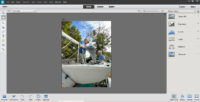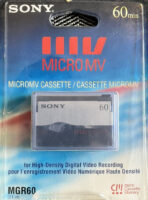See Shawn’s web site:
http://www.shawnlam.ca/
(VU Webcast #2 Script)
Hi ”“ this is Shawn Lam for Videouniversity.com.
Today I’m going to be reviewing the Ily Athena 1 to 11 SATA DVD duplicator controller card, installed in a 13 bay tower. I put this DVD tower together to replace my old ACARD 1 to 8 tower. The old one was working fine but the new one is faster, can burn more discs at a time, and has a better disk image storage and naming system than the old one.
Now you can buy the system pre-installed with all the drives and ready to go out of the box in the US. Seeing I live in Canada I have fewer options and saved a few hundred dollars, largely due to shipping and assembly costs, by ordering my system in a bare bones configuration ”“ that is, only the tower, cables, controller card, and power supply; and I sourced my drives locally. It was also much more fun this way and isn’t too complicated. I’m pretty used to tinkering in computers though as I assemble and upgrade all my own computers. So I’m pretty comfortable with this type of thing but if you are not, then you will want to get your duplicating tower pre-assembled.
First let me start by explaining the technology and components:
A controller card is like a computer’s motherboard and CPU. It is what controls the DVD drives, hence the name: controller. Unlike a computer’s motherboard, a controller card is not mounted to the side of a computer tower, but rather it is mounted in a standard 5.25” bay.
Another difference between a computer and a duplicator controller card is that the controller card doesn’t require an operating system like Windows, software to run the program, or hard drives to store the O/S and software. Controllers use System on Chip (or SOC) technology, update-able by download-able firmware updates.
The controller card connects with DVD drives using regular hard drive cables. IDE is what older systems use. These are the older ribbon type of connections, otherwise known as Parallel ATA. Newer systems, including my Ily Athena model, use the newer Serial ATA connectors. So what is the difference? Well other than the different cables, IDE systems are slower at transmitting data and are quickly becoming obsolete, which makes finding replacement drives more challenging. The faster dual duplex data transfer that SATA offers and larger onboard RAM of newer controller card translates in faster duplicator speeds on newer models. Now I should clarify that the faster speed is not due to faster burning speeds ”“ I burn everything at 8x in an effort to improve compatibility ”“ it is due to faster start times, the time it takes between when you push the copy button and when the buffer loads and the burning begins, which means actually transferring data to the discs.
OK ”“ time for a funny story ”“ I would have liked to show you a side-by-side comparison of my old system to my new one but I actually sold it this morning ”“ so you will have to take my word for it that my new one burns a full DVD about 90 seconds faster, which makes a big difference when you are burning a lot of discs, like I am right now. This being the beginning of July my dance recital season is over and I will be duplicating 20 DVD masters for a total of 2,200 DVDs in the next 2 weeks, so for me that extra 90 seconds is going to make a big difference now but not so much on smaller duplicating jobs.
So we’ve covered-off some of the technology ”“ now let’s have a look at how everything is connected. My case came pre-installed with a power supply and enough connections to power each of my drives, including my hard drive. So the power supply powers the drives and the controller card and the controller card connects to each of the DVD drives and the hard drive.
So while the connections are pretty easy to figure out, cable management becomes a bit tricky when you have 13 devices connected to one small controller card. Thank goodness for the smaller SATA ribbons.
So what is the point of the hard drive? I’ve already mentioned that the controller card uses System on Chip technology and doesn’t require a hard drive. Well the hard drive is optional and is one of the two ways you can duplicate a disc, the other is disc to disc. To use the hard drive you load a master and copy the image to a hard drive partition. It might sound complicated but once you put the disc in the source drive it is a one button function to load.
The front of the controller card has 4 buttons and a small LCD screen and the navigation is pretty straight-forward. Although there are 12 root menus most everything is done through three of them. Number 12 is the Image manager, and is where you can load DVD on to the partition and assign a name; number 8 is the Select Source function, where you decide whether to copy from a DVD source or from an image on the hard drive, and number 1 is the copy menu, which really isn’t a menu at all but when it is selected it serves as the “start” button to commence your DVD duplication.
I’ve been using both my old and my new tower side by side for about a thousand DVDs in the past month ”“ this is how they compare:
As I mentioned before the new model is faster. The new model is also more efficient in allocating its hard drive partitions. The old one occupied 10 GB for each partition when you enabled dual layer burning, so this meant only two partitions on the old 20GB hard drive I had sitting around at the time I put the old system together. The new one creates a partition exactly matching the disc size so no wasted space and depending on disc size, I can load more than 65 DVDs on the 300GB Hard drive than I had pulled out of one of my editing systems because it was too small. Amazing how much has changed in a few years in terms of storage space.
Now the best new feature on the Ily Athena model is the ability to name the partitions, which makes navigating through disc images much easier. My Acard system was a 1 to 7, which means when you have a source disc in the source drive, you can burn to 7 target discs at a time. But when you burned from a disc image on the hard drive you could actually use the source drive as a burner and burn 8 at a time.
The Ily Athena system is a 1 to 11, which means 4 more discs when burning disc to disc, but only 3 more when burning from a hard drive image as the Ily model can only burn to 11 at a time.
When I was at NAB 2009 I visited Acard at their booth and told them I had been using their controller card for years and asked what was new with the newer models. The rep chose to focus on the SATA technology and the improvement in compatibility and consistency with DVD drives it allowed. Essentially he said that past models were picky with the combination of drives you installed. I actually experienced this and at one point swapped my Pioneer drives for NEC models due to compatibility issues with both Prodisc and Taiyo Yuden DVDs but a colleague of mine has the same controller card and the same Pioneer drives I replaced and he hasn’t had any problems.
So when I bought my Ily Athena SATA model I wasn’t too concerned with the brand of drives I chose and ended up getting LG models, which didn’t work properly. A call to Ily tech support revealed that not all drives perform well in their duplicating towers and a quick check on their compatibility list, which for some strange reason is not available on their website, confirmed that LG drives didn’t work with Ily controller cards. I changed to Pioneer burners and the problem went away. They also encouraged me to use a DVD Rom drive as my source drive for better performance but accomplishing this has been nothing but a bag or hurt as very few companies still make and distribute DVD Rom drives with a SATA connection. I finally located a single Asus ROM drive that was on their approved list but it stopped working last week and I have yet to change it. Regardless I was able to change my source drive to one of the Pioneer burners and use it to load my disc images before duplicating.
What else do you need to know when putting together your own duplicating tower? Make sure you get all the parts. For some reason the company that sold my bare bones system didn’t send any screws along to connect the DVD drives with the case. The industry standard is that screws come with the case so they should have included the screws. So when it came to connect 13 components to the case without the 104 screws it requires, I had to do a bit of rummaging thought my parts drawer as and even my computer supplier didn’t have that many lying around. I eventually ordered a bag from another supplier.
Now a few last notes to wind-down this exclusive Videouniversity.com review and because I know I’ll get asked.
How does the Ily Athena compare with new Acard controller cards?
I never got a chance to test any Acard models but I wouldn’t expect any performance differences and I confirmed with ACard that their 1 to 11 model can only burn 11 at a time, even when burning from a hard drive image.
How come you chose the Ily model over the Acard model?
Local availability. ACard does not have any dealers in Canada and I didn’t want the hassle of importing and paying for additional handling versus finding a Canadian supplier, which Ily has. ACard did want to sell me a controller directly but were not able to find me a suitable case supplier so I went for the Ily base bones system with case, power supply, and cables.
So there you have it ”“ my new duplicating tower using the Ily Athena 1 to 11 SATA duplicating controller card.






Good review.
I have built a couple duplicators with Ily parts and Athena cards. They work very well. My cases came without screws also. Anyone with basic mechanical skills can assemble one.
Thanks Bob. I’m still scratching my head as to how they can ship a case without $2.00 worth of screws that are necessary to complete the installation of the burners…
Just a few more notes that I didn’t get to include in the original article. The controller card I am using is forward compatible with Blu-ray discs. I know I don’t need to spell it out to the readers of VU but just so we are clear – you need to install Blu-ray burners to burn Blu-ray discs.
Thank you for the information. I had tried to find out how to build your own before purchasing a Vin Power duplicator a few years ago. Now, I can increase my capacity more affordably.
One question: Are you able to change out drives without major reconfiguration?
Hey Richard – thanks for the feedback. You can swap drives very easily. and I would suggest updating the firmware while you are at it. The manufacturers tell me that the advantage of SATA is that you can mix and match drives and replace one if one does fail but my experience has been that it is always best to choose drives from their approved list and to match drives/brands whenever possible. To get Ily’s approved list you have to call their tech support as they don’t post on their website… Personally, if I had a drive fail and a matching model wasn’t available, I would probably change them all out, which is exactly what I did on my old duplicator.
We’ve just released a new product called “Start Your Own Video Duplication and Transfer Businessâ€
http://www.videouniversity.com/shop/start-your-own-video-duplication-and-transfer-business
Smart services to offer in you own a video business.